Physical Address
304 North Cardinal St.
Dorchester Center, MA 02124
Physical Address
304 North Cardinal St.
Dorchester Center, MA 02124
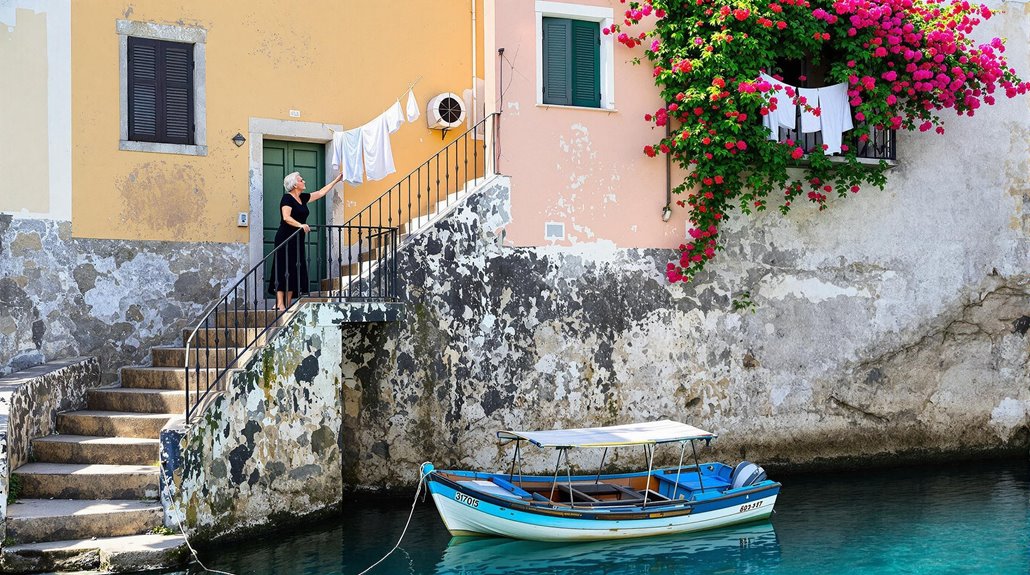
If you're tired of jostling through crowds at the Colosseum or waiting in endless lines at the Vatican, Italy has much more to offer beyond its famous landmarks. You will discover hidden valleys where locals "adopt" apple trees, medieval towns clinging to cliff faces, and ancient thermal springs that won't break your budget. These lesser-known destinations let you experience authentic Italian culture without the tourist markup or packed piazzas. Let's explore some of Italy's best-kept secrets.
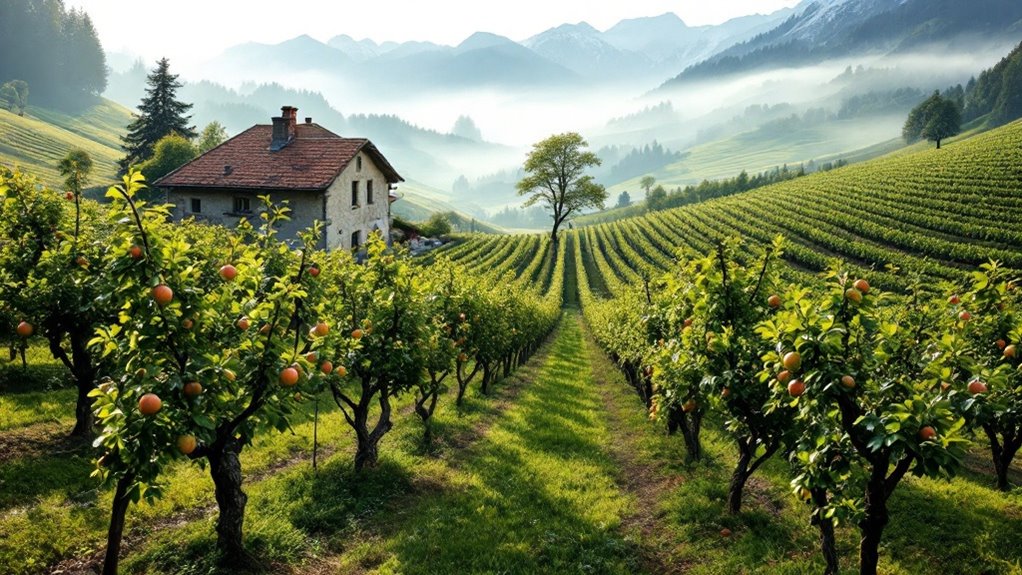
A patchwork of apple orchards blankets northern Italy's Val di Non valley, where 7,000 hectares produce an astounding 300 million kilos of apples annually.
Here, you'll discover Italy's only DOP-certified apples, with 13 varieties including the historic Renetta Canada, perfect for traditional strudel.
Time your visit for April to witness pink and white blossoms transform the landscape, or come during the September-October harvest when you can join the "Adopt a Tree" program.
Don't miss Melinda's underground storage caves, converted from former mines.
Cycle the Road of Apples trail for sweeping views of orchards against the Brenta Dolomites backdrop. The region's celebrated Mortandèla sausage adds a savory dimension to local food tours.
For the best photos, head to Flavon village, where medieval Castel Thun rises above the endless rows of apple trees.
While Trentino's apple orchards showcase Italy's agricultural charm, the medieval village of Castelmezzano invites you into a different world entirely.
This hidden gem in the Lucanian Dolomites offers dramatic mountain views and houses carved directly into cliffs, all accessible through a rock-carved tunnel entrance. As a village dating back to the Norman period, Castelmezzano preserves its rich historical heritage through its architecture and traditions.
You'll find authentic experiences without tourist crowds, starting with these must-do activities:
Stop by Trattoria Al Vecchio Scarpone for local specialties like wild boar ragu and homemade sausages.
For thrill-seekers, the Volo dell'Angelo zipline lets you soar between villages at 120 km/h, offering an unforgettable perspective of this medieval wonder.
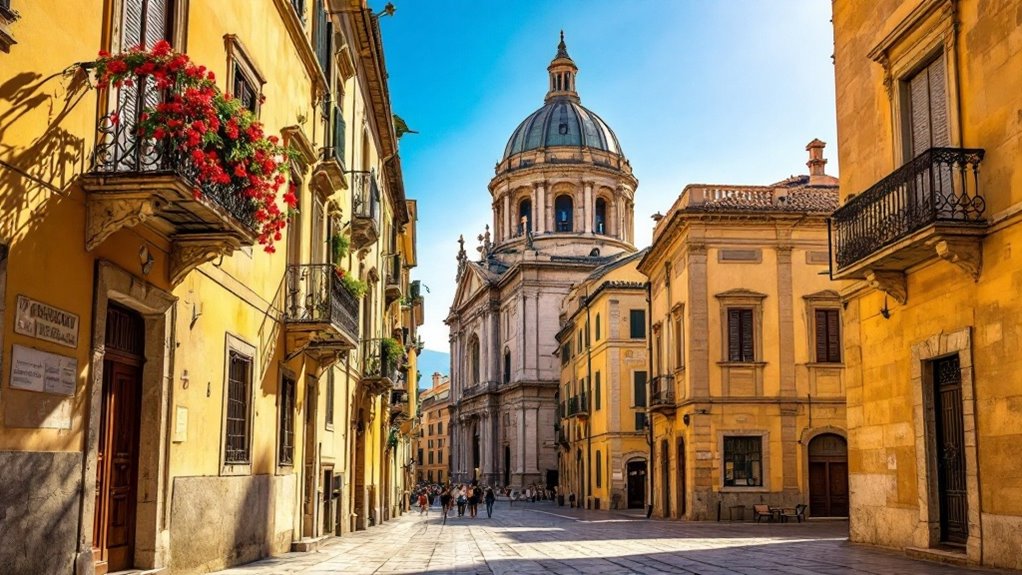
Three centuries after a devastating earthquake, Ragusa Ibla stands as Sicily's crowning achievement in Baroque architecture.
The 1693 twin earthquakes destroyed over 50 towns in southeastern Sicily, leading to the region's remarkable rebirth.
You'll discover nine major churches and seven palazzi within its UNESCO-protected historic core, where local limestone creates stunning façades with spiraled columns and floral motifs.
Don't miss the Duomo di San Giorgio's dramatic 250-step staircase or Palazzo La Rocca's unique balconies featuring carved figures.
For the best views, climb to Santa Maria delle Scale church, where you can photograph both Ragusa Ibla and Superiore across the valley.
Visit during spring or fall to avoid crowds and high temperatures.
Stay in the pedestrianized center and use it as a base to explore nearby UNESCO towns like Modica, famous for its chocolate, and Scicli with its impressive palazzi.
Local buses connect you to all major sites.
Marvel at one of the Mediterranean's largest ancient burial complexes in Tarquinia, where over 6,000 Etruscan tombs reveal stunning frescoes and domestic architecture from the 8th-3rd centuries BCE.
Step back in time through 6,000 ancient Etruscan tombs showcasing vibrant frescoes and architectural wonders from a lost Mediterranean civilization.
The site gained prestigious UNESCO World Heritage status in 2004, recognizing its exceptional cultural significance.
You'll discover lively wall paintings depicting ancient banquets, dancing, and mythological scenes, all preserved through climate-controlled chambers and sealed metal doors.
To make the most of your visit:
Located just 90 minutes from Rome, these UNESCO-listed tombs offer a unique glimpse into Etruscan life, with roughly 12 tombs open at any time for preservation purposes.

From ancient tombs to surreal sculptures, Italy's artistic legacy takes an unexpected turn at the Monster Park of Bomarzo.
You'll discover this offbeat attraction just 80 km north of Rome, where over 30 grotesque statues inhabit a woodland that defies Renaissance symmetry.
Commissioned in 1552 by Prince Orsini to process his grief, the park features mind-bending highlights like a giant mouth with an acoustic chamber, a tilted house that'll throw off your balance, and an elephant crushing a soldier. Artists like Salvador Dalí drew inspiration from these surreal gardens.
You can explore it all for €12, and kids under 4 enter free.
Visit between 8:30 AM and 7:00 PM in summer, or 9:00 AM to 5:00 PM in winter.
Pair your trip with stops at nearby Villa Lante or medieval Viterbo for a full day's adventure.
Tuscany's natural wonder, the Saturnia Springs, invites you to soak in therapeutic 37°C waters cascading through ancient travertine pools.
Unlike Italy's tourist-packed attractions, these thermal springs offer a free, peaceful escape in Maremma's countryside, just 1.5 hours from Rome.
The enchanting thermal waters produce an impressive 800 liters per second of sulphurous water that continuously feeds the cascading pools.
The best times to visit are:
You'll find plenty of budget-friendly agriturismos nearby, making it easy to plan multiple soaks in the mineral-rich waters.
Don't miss exploring the surrounding medieval villages like Pitigliano, where you can sample local pecorino cheese and Bianco di Pitigliano wine between dips in the thermal pools.
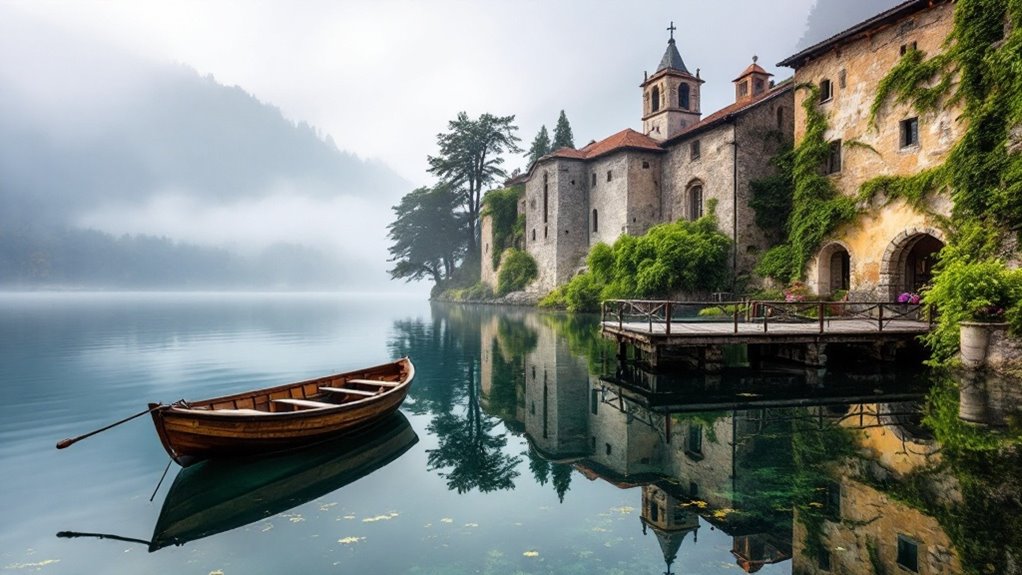
While Saturnia's springs offer natural therapy, Lake Orta beckons with spiritual serenity on its San Giulio Island, home to a thriving Benedictine monastery since 1973.
You'll discover this hidden gem just a quick 2-minute ferry ride from Piazza Motta, with no advance booking needed.
Walk the island's perimeter path, choosing between the "Way of Silence" or "Way of Meditation," both featuring contemplative inscriptions. The island houses a community of nearly eighty nuns who maintain its peaceful atmosphere.
Visit the free-entry Basilica di San Giulio to admire medieval frescoes and Romanesque architecture. The monastery sustains itself through handcrafted liturgical items and antique restoration, which you can purchase at the seasonal gift shop.
Time your visit before 6 PM when ferry service ends, and avoid November when the island observes its monastic retreat.
Remember to maintain silence – it's not just tradition, it's required.
Perched in Puglia's Valle d'Itria, the whitewashed town of Locorotondo lives up to its Latin name "round place" with a perfectly circular historic center.
High in Valle d'Itria, Locorotondo's brilliant white maze of streets forms an ancient circle atop the Puglian landscape.
You'll encounter unique "cummerse" houses with geometric limestone roofs and flower-filled balconies lining the concentric alleys. The town's rich history dates back to 1000 AD, when it began as a small hamlet under Benedictine monastery control.
For the best experience, visit during these quieter seasons:
A rental car's essential since public transport is limited, but you'll be rewarded with easy day trips to nearby attractions.
Base yourself here to explore Alberobello's trulli (12 minutes away), sample local DOC white wines, and discover authentic Pugliese cuisine like orecchiette pasta and fresh burrata cheese.
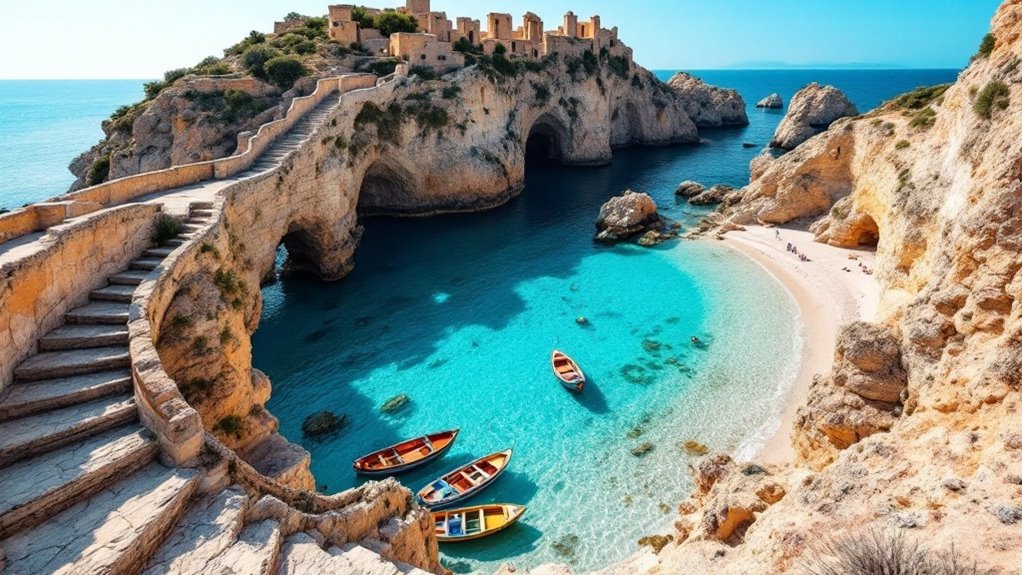
Between Rome and Naples lies Sperlonga, a dazzling coastal gem where Emperor Tiberius once built his seaside villa.
You'll discover ancient history seamlessly woven into this whitewashed medieval town, with defensive towers from the 1500s still standing guard over crystal-clear waters.
Unlike the tourist-heavy Amalfi Coast, Sperlonga offers a more authentic Italian beach experience. You can explore the National Archaeological Museum, snorkel in protected WWF waters, or hike coastal paths connecting beaches to historic sites. Local festivals celebrating ancestral cultural heritage and traditions bring the town's rich history to life throughout the year.
The town's commitment to sustainable tourism means you'll enjoy Blue Flag-certified beaches without the crowds.
Visit between March and June to save money and avoid peak season when the population doubles.
Direct buses from Fondi-Sperlonga station make getting around easy, and you'll find affordable accommodation from family-run B&Bs to beachfront hotels.
Standing majestically on three chalk hills, Brisighella's medieval towers dominate the Lamone Valley skyline and tell a fascinating story of 13th-century defense.
Perched atop three dramatic chalk hills, Brisighella's ancient towers stand guard over the Lamone Valley, echoing centuries of medieval might.
You'll discover three remarkable structures: the Rocca Manfrediana with its distinctive circular towers, the Clock Tower with its unique six-hour dial, and the Baroque-styled Sanctuary of Monticino. The Clock Tower's timekeeping relies on a six-hour system installed in 1850.
Don't miss these free experiences:
The Rocca's museum brings the region's chalk-mining heritage to life through multimedia exhibits, while the nearby Monticino geological museum lets you explore an actual chalk cave.
It's an off-the-beaten-path destination that won't strain your budget.
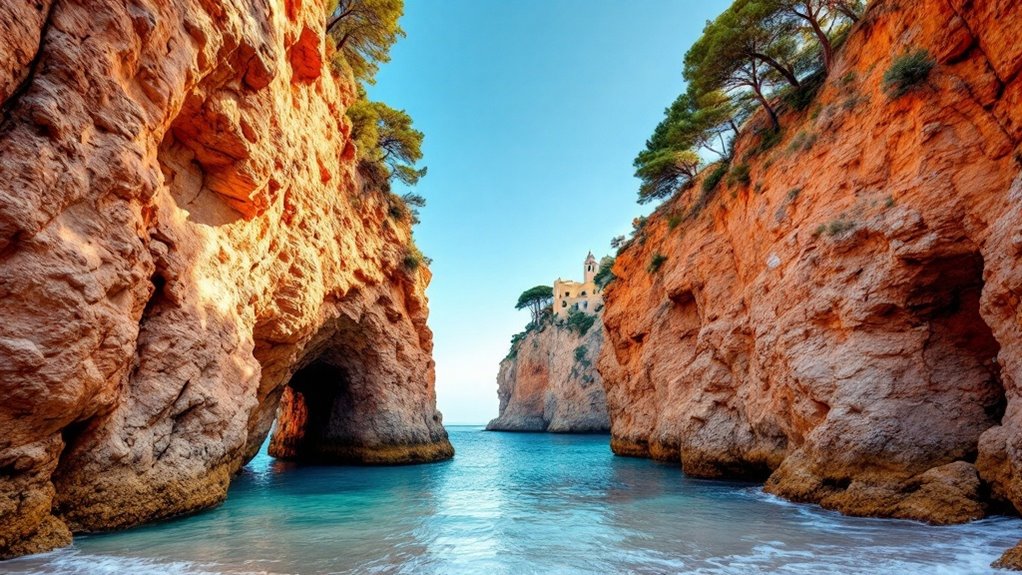
The dramatic red cliffs of Tropea rise 50-100 meters above the Tyrrhenian Sea, forming one of Italy's most spectacular coastal landscapes.
You'll discover this hidden gem along Calabria's Costa degli Dei, where white-sand beaches and turquoise waters await.
Visit in May or September when temperatures hover around 72°F and crowds thin out.
Don't miss the iconic Santuario di Santa Maria dell'Isola, accessible via 300 carved steps, or the sunset views from Belvedere Piazza del Cannone. According to local legend, this monastery has protected residents by receiving Virgin Mary's earthquake warnings.
The nearby public beach at Marina dell'Isola offers free access to crystal-clear waters.
While you're here, taste the famous red Tropea onions and local Cirò wine along Corso Vittorio Emanuele III.
You can fly into Lamezia Terme Airport, 50 km north, and consider day trips to Capo Vaticano's secluded coves.
Nestled in Italy's Trentino region, Lakes Levico and Caldonazzo offer pristine alpine waters and crowd-free beaches just 20km from Trento.
You'll discover crystal-clear swimming from May through September, with water temperatures reaching a comfortable 26°C. The area is renowned for its therapeutic mineral springs that feed the famous spas of Levico and Vetriolo. Unlike touristy Lake Como, these Blue Flag-certified lakes maintain their authentic charm while providing essential amenities.
For outdoor enthusiasts, these lakes deliver:
Stay in affordable agriturismos or campgrounds near Pergine Valsugana, using public transport to explore nearby thermal springs, Roman ruins, and traditional markets.
Visit during May, June, or September to experience the lakes at their quietest.
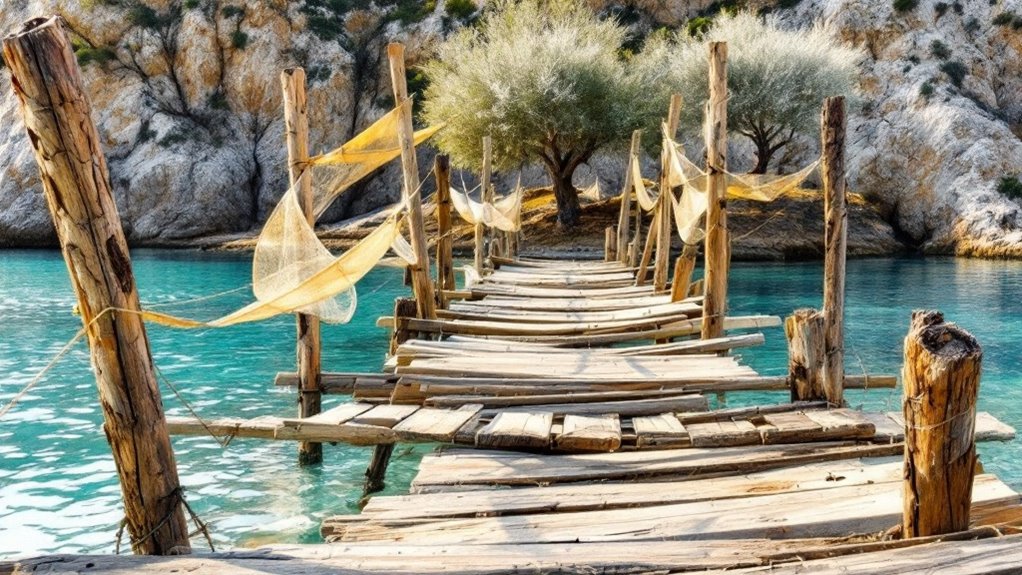
Along Abruzzo's untamed Adriatic coastline, the Trabocchi Coast stretches 50km from Ortona to Vasto, offering a remarkable alternative to Italy's crowded seaside destinations.
You'll discover 23 historic wooden fishing platforms called trabocchi perched on stilts above the turquoise waters, with several now serving as unique seafood restaurants.
The coast's diverse landscape features everything from hidden coves to golden beaches.
Don't miss Punta Penna Beach within the Punta Aderci Nature Reserve or the secluded Ripari di Giobbe, accessible via cliffside walkways.
For an active day out, cycle the 42km Via Verde path along a former railway line or hike from beaches to hilltop villages like San Vito Chietino. Visitors can enjoy traditional fishing experiences aboard a trabucco to learn about local methods.
Visit between May and September when sea temperatures reach 28°C and you can fully explore this authentic slice of Italian coastal life.
You will discover these hidden Italian treasures offer authentic experiences at a fraction of the cost of major tourist destinations. Pack your walking shoes, download offline maps, and plan your visits during shoulder season for the best deals. Consider staying in local guesthouses and using regional trains to maximize your budget. These lesser-known spots let you experience real Italian culture without breaking the bank.